Have you ever dreamt of a perfect pepper garden? A garden bursting with lush green foliage and vibrant pepper plants, flawlessly planted in organized rows? Planting peppers is a great way to add a splash of color and flavor to your garden. But to achieve this perfect pepper patch, it’s important to understand the basics of companion planting for peppers. In this Guide, we will help you create your own perfect pepper patch!
What Are Peppers?
Peppers are a type of vegetable that comes in many shapes, sizes, and colors. They range from sweet to spicy and can be eaten raw or cooked.
Peppers provide numerous health benefits such as providing vitamins C and A, fiber, antioxidants, and even some protein. The capsaicin found in hot peppers is also beneficial for boosting metabolism and aiding digestion.What Are the Benefits of Companion Planting?
Companion planting is the practice of growing different plants together to help each other flourish. When done correctly, companion planting can benefit your garden in a variety of ways:
- Decrease pests and diseases: Certain plant combinations, such as peppers with marigolds or beans with garlic, naturally repel insect pests and attract beneficial insects that prey on pests. Other pairings can also improve air circulation, reduce fungus and mildew growth, and inhibit the spread of certain diseases.
- Increase pollination: Planting flowers near vegetables provides a food source for pollinators like bees and butterflies who will then visit nearby flowering vegetables and help with pollination.
- Improve soil quality: Some companion plants are known for having deep root systems that can help aerate the soil and bring up nutrients from deeper layers. Others have dense foliage that will shade out competing weeds, while still others are nitrogen-fixers, meaning they take nitrogen from the air and convert it to a form plants can use.
- Having companion plants of different heights around your pepper plants will also provide much-needed shelter for them during windy days or heavy rains.
- Enhance flavor: Growing certain herbs alongside your peppers can actually improve their flavor profile, adding notes of basil or oregano depending on what you’ve planted.
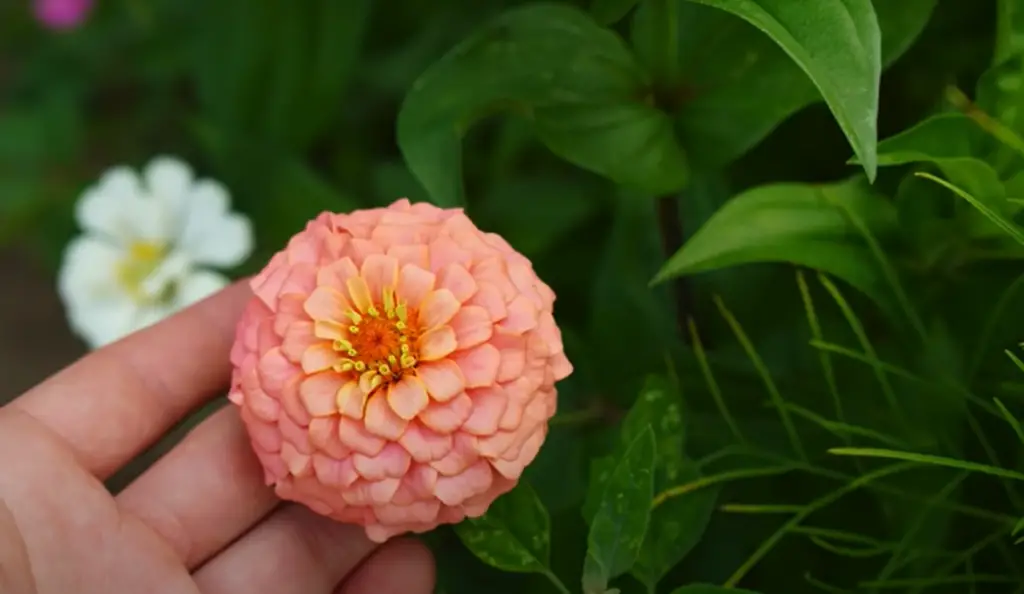
Read on to learn more about which plants make good companions for peppers and how to get started.
Benefits of Companion Plants
Companion plants can provide many benefits to peppers planted in a garden. They help with pest control by deterring certain insects, they can increase soil fertility and nutrient availability, and some of them even help protect peppers from extreme temperatures.
Some companion plants also attract helpful beneficial insects that eat pests, such as the hoverfly. Other examples of beneficial insects include ladybugs, lacewings, pirate bugs, parasitic wasps, and tachinid flies — all of which feed on aphids and other soft-bodied insects.
In addition to these benefits, companion plants also create an attractive garden landscape. Many companion plants have flowers or other colorful features that draw the eye while providing habitat for birds and pollinators such as bees, butterflies, and hummingbirds.
Overall, companion plants are an important gardening tool that can help boost pepper plant growth and keep pests away. This makes them an integral part of any successful pepper garden!
Choosing Companion Plants for Peppers
When choosing companion plants to add to your pepper garden, it is important to consider the type of pepper you have planted as well as other factors such as climate and soil conditions. For instance, some plants may not grow well in certain climates or soils, while others can thrive in different conditions.
It is also important to research what kind of insects the companion plant attracts so you don’t accidentally attract harmful bugs instead! Some good examples of potential companion plants for peppers include marigolds, nasturtiums, dill, parsley, and oregano.
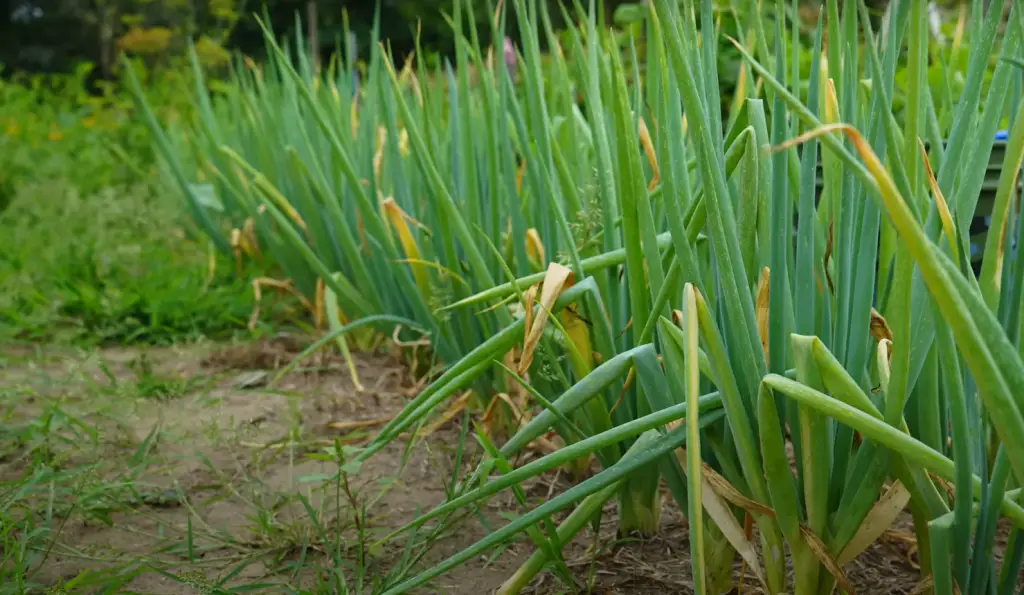
Finally, remember to give each plant enough space to grow. When planting your companion plants around peppers, ensure there is enough distance between them so the roots don’t become tangled or crowded.
Excellent Companion Plants for Peppers
When it comes to planting peppers, companion plants can provide a host of benefits. They look great in the garden and help deter pests and improve soil quality – all while helping your peppers thrive! Here are some of the best companion plants for peppers.
Garlic
Growing garlic alongside your peppers is a great idea for two reasons. First, its strong aroma will keep pests away from your pepper plants. Second, the natural sulfur in garlic is beneficial to the soil and can help promote healthy pepper growth. Keep in mind that you’ll want to plant them a good distance away from your other vegetables so that their strong odor doesn’t overpower everything else. When planting garlic, make sure to put it into full-sun areas and water it regularly so it grows well. You can harvest the cloves once they mature and use them for cooking or as companions for your pepper plants!
Chives
Chives are a great companion plant for peppers! This hardy perennial makes an excellent border or edging plant, and can even be planted in containers. Chives thrive in well-drained soil and full sun, and they produce fragrant flowers from late spring to early fall. The flowers attract bees which helps with the pollination of peppers (and other vegetables). Plus, the foliage of chives is edible — they taste delicious chopped up into salads, sauces, soups, and more! Plant them near your pepper plants to help keep away aphids and other pests that may try to attack your peppers. Just make sure you don’t water too much as this can cause root rot. Enjoy the beauty of chives in your garden!
Snapdragon
Snapdragons are popular companion plants for peppers as they thrive in full sun and attract beneficial insects to the garden. Snapdragon’s bright yellow or orange flowers will bloom all season long, adding a splash of color to your pepper patch.
When planting snapdragon alongside your pepper, leave enough room between them so that their roots have space to spread out. Additionally, remove dead blooms on a regular basis in order to encourage continuous growth and flowering throughout the season. Keep an eye out for pests such as aphids which could damage both your snapdragons and peppers if left untreated. With proper care, snapdragons are sure to add a pop of color and attract helpful insects to your garden. Happy planting!Borage
Borage is a fantastic companion plant for peppers. It has the ability to attract beneficial insects such as bees and hoverflies that help pollinate your pepper plants, as well as provide an additional source of food for them.
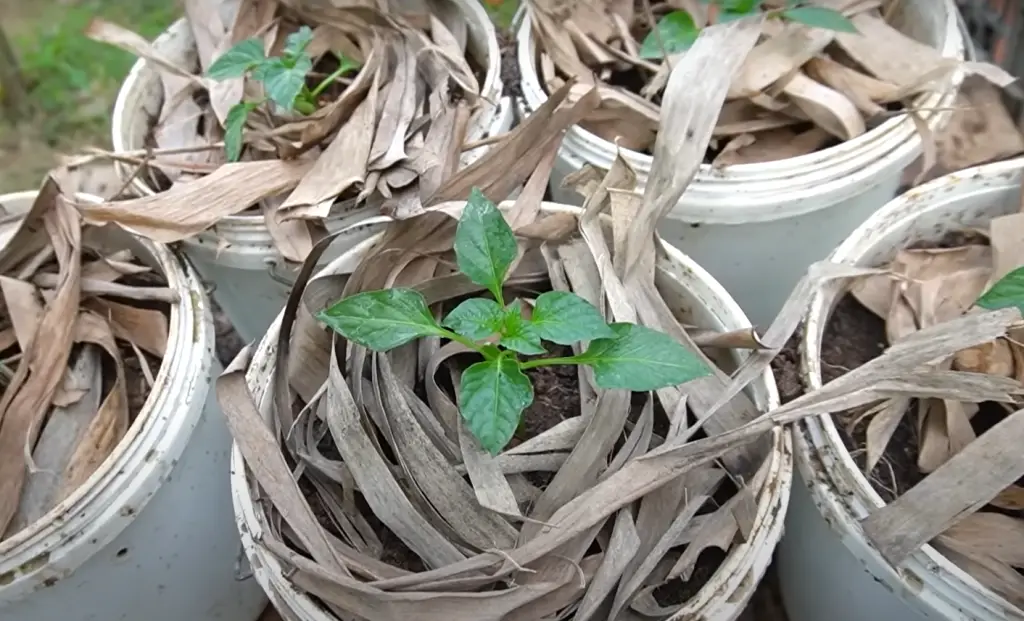
Borage also helps repel pests such as tomato hornworms and cabbage loopers, which can be a problem in some areas. When planting borage around your peppers, make sure to keep it away from other Brassicaceae (cabbage family) crops such as broccoli or cauliflower, as it can promote cross-pollination between these vegetables. Additionally, borage is a great source of nectar for butterflies and hummingbirds, making it both a functional and beautiful addition to any garden!
Cilantro
Cilantro grows quickly and provides an intense flavor to any dish. Its strong aroma is said to repel many of the pests that commonly affect peppers, including aphids, spider mites and squash bugs. Additionally, cilantro’s dense foliage creates a barrier between your pepper plants and the soil surface, helping to keep moisture in and weeds out. When planting cilantro with your peppers, be sure to give them plenty of space – their roots can spread quite far! Finally, if you want an extra flavor boost in your dishes, consider adding some fresh cilantro leaves as a garnish.
Carrot
Carrots make use of the same nitrogen that peppers need, so they can grow side by side without competition. As an added bonus, carrots even help to repel certain pests like aphids and cabbage worms which can be harmful to pepper plants! Planting them near your pepper patch will help ensure your peppers are protected from these pests. In addition, carrots also attract beneficial insects like ladybugs which prey on common garden pests, helping to keep the balance in your garden ecosystem. Lastly, the deep roots of carrots have been known to loosen up hard soil and bring nutrients closer to the surface – this means more nutrient-rich soil for your peppers!
Sweet Marjoram
This herb is a great companion for your pepper plants. Sweet marjoram improves the flavor of peppers and helps keep away pests. Plant sweet marjoram around your peppers to increase their growth, vigor, and flavor. Plus, it has a pleasant aroma that will add to your garden’s overall ambiance! Make sure to give them enough space as this herb grows up to two feet tall. It does well when planted in full sun or partial shade, so you have some flexibility with its location in the garden. Be sure to water regularly for optimal health of both the sweet marjoram and your peppers.
Oregano
Oregano is a great companion plant for peppers, especially in Mediterranean climates. It not only provides flavor to any dish you might make with your home-grown peppers, but it also helps repel pests like aphids. Oregano grows best when planted in well-draining soil with plenty of sun. Plant the oregano near your pepper plants and enjoy the benefits of having an all-star herb nearby! Just be aware that oregano can become invasive, so prune regularly and keep on top of those weeds!
Rosemary
Rosemary is a great companion plant for peppers. It will help keep pests away and improve soil quality, as well as add an aromatic fragrance to your pepper patch. Planting rosemary near pepper plants can help reduce the risk of root rot due to its strong antifungal properties.
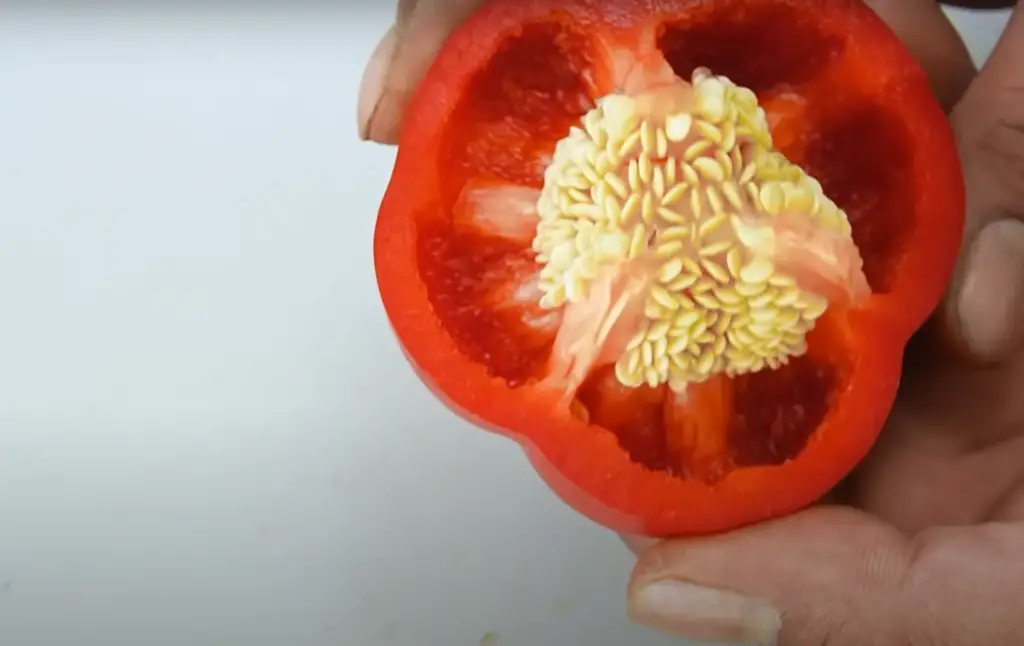
Rosemary also helps deter some common garden pests like aphids, mites, cabbage loopers, flea beetles and bean beetles. Its sharp-scented leaves can confuse them and make it difficult for them to find their way to your peppers. Be sure to give the rosemary enough space when planting so that it does not crowd out other plants in the garden. Rosemary prefers full sun and dry soil with good drainage. Water only when the soil is dry and gives it plenty of air circulation. If you plan on harvesting leaves for culinary use, be sure to prune regularly so that the plant can continue to thrive.
Tomato
Tomatoes provide several benefits. For example, tomatoes can help repel some pests that may harm peppers. They also contain a natural fungicide which helps prevent the spread of disease from one pepper to another. Tomatoes also act as a living mulch, helping to retain moisture around the plants which is essential for healthy growth. Additionally, the tomato plants will draw nitrogen from the air and convert it into usable form in their roots, providing an extra boost of nutrition for the peppers. When planting tomatoes alongside peppers, make sure to provide adequate spacing between them to ensure proper airflow and discourage overcrowding.
Fava Beans
Fava beans are an excellent companion plant for peppers, offering nitrogen and shade to the plants. They can be planted either in front of or behind your pepper plants – it’s entirely up to you! If you want maximum benefits, try planting them near the base of the pepper plants, as this will help keep their roots cool and moist during the hot summer months. Fava beans are relatively easy to grow and require little maintenance, making them a great choice for beginner gardeners. When harvesting fava beans, be sure not to pick any that haven’t fully matured – if they’re still green inside they won’t taste good! Keep an eye out for signs of disease such as wilting leaves or brown spots on the pods, which indicate infection by fusarium wilt. Harvest your fava beans as soon as they’re ready, and enjoy their delicious taste in salads, soups, and more!
Basil
Basil is a popular herb that makes an excellent companion for pepper plants. This fragrant, low-maintenance plant helps ward off pests and provides the peppers with necessary nutrients. Stay away from Cinnamon Basil while planting near peppers, as this variety will stunt their growth and cause them to produce fewer fruit. Plant basil with your peppers in spring or early summer when temperatures are still mild. When it comes time to harvest, be sure to remove any dead foliage from around the pepper plants as soon as possible. This will help reduce disease and deter pests that may otherwise plague your crop. Finally, don’t forget to water your basil regularly – it needs plenty of hydration to thrive!
Marigold
Marigold (Tagetes) is a perfect companion to peppers. Marigolds are known for their ability to repel harmful nematodes and other pests that might attack your pepper plants. Planting one or two marigolds next to the pepper plant can deter these pests from bothering the peppers. The bright yellow and orange flowers of marigolds also make peppers stand out in the garden, adding a splash of color. Since both marigolds and peppers enjoy sunny positions, they work well together.
Remember to water regularly and keep an eye on any potential weeds that threaten to choke out your pepper plants.Nasturtium
Nasturtiums are great companions for peppers due to their ability to repel pests. As an added bonus, they attract beneficial insects like hoverflies and ladybugs that help pollinate peppers! Nasturtiums have bright flowers of yellow, orange, and red which can add interest to your garden. They prefer well-drained soil in full sun or partial shade and will spread quickly if not kept in check.

Plant them near peppers but keep some distance so the nasturtium foliage won’t get in the way of harvesting the pepper fruits. Deadhead the flowers regularly to encourage more blooms and remember that all parts of the plant are edible so you can enjoy these tangy flowers (and their peppery leaves!) in salads or other dishes. With proper care, nasturtiums can be a great addition to your pepper garden!
Onion
Onions naturally repel aphids, mites, and other pests, which makes them an excellent addition to your pepper garden. Onions also help add nutrients to the soil, making it easier for peppers to thrive. When planting onions near your peppers, you should make sure that they are spaced out so the leaves don’t touch each other as this could lead to disease or fungus problems. If space is limited in your garden beds, try mixing onion bulbs with pepper plants by planting them together in the same hole – just make sure there’s enough room for both of them! Additionally, when harvesting onions from a garden bed with peppers growing nearby, be careful not to accidentally pull up any of the pepper plants as you work. With this simple tip, your peppers and onions will be happy together!
Spinach
Spinach is a great pepper companion plant. The shade it provides helps peppers stay cool and prevents them from overheating in the sun.
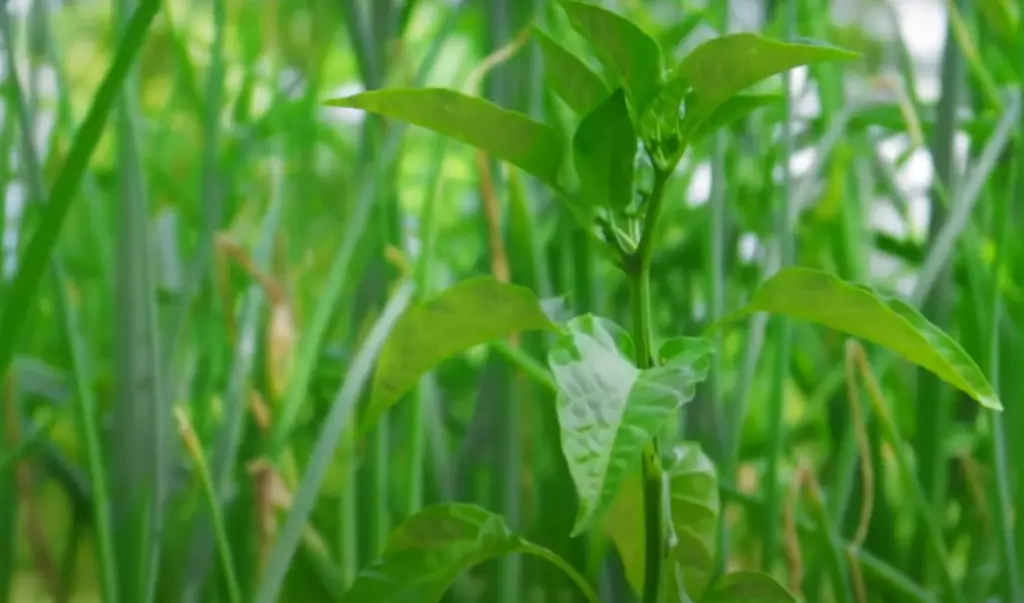
It also helps keep the moisture around peppers, which can be beneficial during dry spells. Plus, spinach takes up valuable space that weeds would otherwise occupy, making your garden look neat and tidy! Make sure to harvest your spinach regularly so that the plants don’t compete too much with your pepper plants for nutrients. Lastly, beware of planting spinach near chilies as the heat from them can damage its leaves or stunt its growth. [1]
Worst Companion Plants for Peppers
Not all plants are compatible with peppers. In fact, some of them can even be harmful to your pepper garden. Here is a list of the worst companion plants for peppers.
Cauliflower
Cauliflower is a member of the cabbage family, and should not be grown near peppers. The strong aroma of the cauliflower can inhibit the growth of the pepper plants. Additionally, cauliflower may attract pests that are also attracted to peppers, such as aphids. If you are planting cauliflower in your garden, keep it away from your pepper plants!
Cabbage
Just like cauliflower, cabbage is a member of the cabbage family and should not be planted near peppers. The smell of cabbage can prevent the growth of pepper plants and also attract pests. It’s important to keep cabbage and pepper plants separate because they compete for essential nutrients in the soil.
Broccoli
Do not plant broccoli near peppers because both vegetables belong to the cabbage family. It produces an aroma that can inhibit the growth of pepper plants, as well as attract pests. Additionally, it competes with pepper plants for essential nutrients in the soil. Keep your broccoli and peppers separate!
Fennel
Fennel is a popular herb, but it should not be planted near pepper plants. Fennel excretes a substance that can weaken peppers and inhibit their growth.

Additionally, fennel may attract pests that could also feed on your pepper plants. Keep your fennel away from your pepper garden!
Eggplant
Although eggplant is a popular vegetable, it should not be grown near pepper plants. Eggplants produce an aroma that can inhibit the growth of pepper plants and attract pests. Additionally, they compete with peppers for essential nutrients in the soil. Keep your eggplants and peppers separate!
Potato
Potatoes and peppers should not be grown near each other. Potatoes are prone to several diseases, including blight, which can spread to pepper plants if they’re grown too close together. Moreover, pepper plants may be susceptible to pests that are attracted to potatoes as well. Keep your potatoes away from your pepper garden!
Corn
Corn is a great companion to peppers, as it serves as an attractor for beneficial insects such as ladybugs. Not only that, but corn can help protect peppers from pests by luring them away from the plants. When planting corn in your garden, make sure to space it out well so that the surrounding air circulation is adequate. Planting near a windbreak or shelterbelt will also help protect the corn and pepper plants from strong winds and other weather extremes.

Keep in mind that if you’re growing hot peppers, such as jalapenos or habaneros, they will cross-pollinate with sweet varieties of corn and affect their flavor. It’s best to plant different types of pepper and corn together on opposite sides of the garden to avoid this. With proper spacing and attention to your plants, corn can help bring in beneficial insects while also protecting your pepper plants from pests. [2]
FAQ
What should not be planted next to peppers?
When it comes to companion planting, some plants should not be planted next to peppers. This is because they can interfere with the growth of pepper plants and even hamper their health. Examples of such plants are cabbages, eggplants, potatoes, and okra. Additionally, stay away from any type of cabbage or cruciferous vegetables as well. These veggies attract harmful pests which can easily infect your pepper crop! Lastly, avoid putting your peppers in close proximity to fennel since this herb will compete for nutrients with the peppers and weaken them over time. [3]
What is the best companion plant for peppers?
There are many plants that make great companions for peppers, so it really depends on what you’re looking for. Marigolds and nasturtiums work well as pest repellents while basil and oregano can increase the flavor of your peppers. Carrots, bean plants, parsley, rosemary, chamomile and sage also have a synergistic relationship with pepper plants.
What plants to avoid with bell peppers?
Bell peppers are a popular vegetable to grow in the garden, and many people want to know which plants should be avoided when planting bell peppers.
Here are some of the top plants that you should avoid when growing bell peppers:
- Potatoes: Potatoes tend to attract aphids, which can spread diseases among other nearby crops like your bell peppers. So it’s best to keep potatoes away from bell peppers altogether if possible.
- Eggplants: Eggplants and bell peppers are both members of the nightshade family, so they should not be planted too close together. This can lead to cross-pollination and lower yields for both plants.
- Fennel: Fennel is a popular companion plant for many vegetables, but it should be avoided when growing bell peppers. Fennel has a tendency to reduce the flavor of bell peppers when planted too close together.
These are just some of the main plants that you should avoid when planting bell peppers. For more specific information about which companion plants work best with your bell pepper crop, contact your local garden center or extension office for advice. With careful consideration, you can ensure that your bell peppers are a success this season!
What can I plant next to peppers and tomatoes?
There are many plants that can be planted next to peppers and tomatoes, all of which have various benefits.
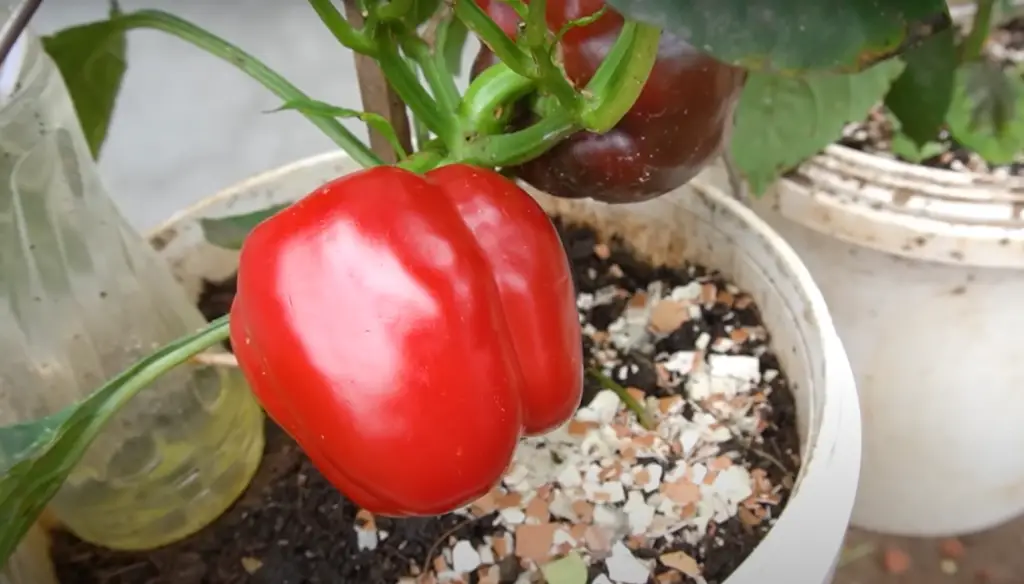
Some of the best companion plants for peppers and tomatoes include:
- Basil – Not only does basil deter pests, but it also helps protect both pepper and tomato plants from disease.
- Marigolds – These bright flowers not only make your garden look beautiful, they also help attract pollinators as well as repel certain harmful insects.
- Nasturtiums – Planting nasturtiums near peppers and tomatoes is a great way to keep harmful bugs away while providing nutrition to the ground soil with their nitrogen-rich foliage.
- Carrots – Planting carrots near peppers and tomatoes can help keep pests away as well as provide some additional nutrition to the soil around them.
- Garlic – Planting garlic near peppers and tomatoes is a great way to deter some common garden pests, while providing a nice aroma throughout the area. [4]
Overall, planting companion plants next to your pepper and tomato plants can not only make your garden look beautiful but also reduce pest pressures and provide added nutrition for the surrounding soil. Try out some of these companion plants in your pepper and tomato gardens this season!
Useful Video: Companion Planting // 16 Companion Plants for Peppers!
Conclusion
In conclusion, finding the perfect pepper companion plants for your garden can be a challenge. However, with some research and careful planning you can create a lush garden of peppers that will thrive for many years to come. When choosing companion plants for your peppers, make sure to select ones that are beneficial to each other. Avoid planting combinations known to be detrimental to one another as this could cause problems in the long run. With a little bit of effort you can create a beautiful and productive garden full of healthy pepper plants! Good luck!
References:
- https://www.thespruce.com/pepper-companion-plants-7486883
- https://www.gardenia.net/guide/best-worst-companions-for-peppers
- https://www.ruralsprout.com/pepper-companion-plants/
- https://www.bhg.com/best-companion-plants-for-peppers-7112778










Leave a Reply
View Comments